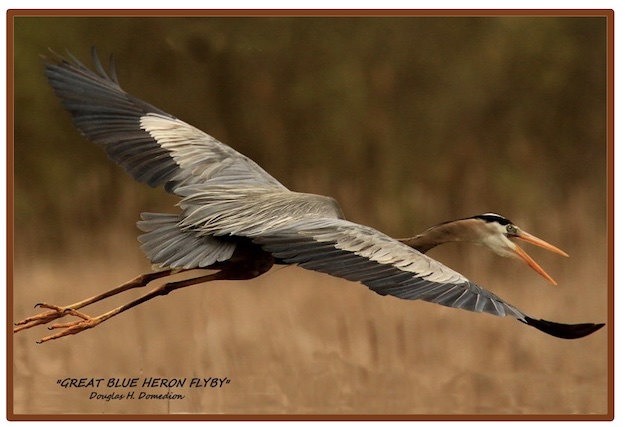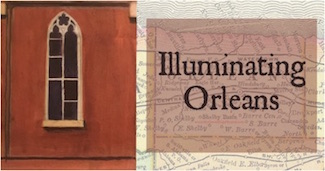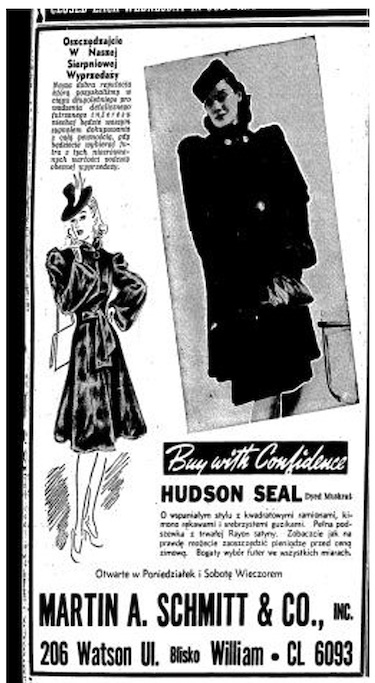Local wildlife management area created in 1941 after concern over big muskrat operation for furs

The Great Blue Heron, one of the many birds who benefited from the establishment of wildlife management areas locally. (Photo courtesy of Doug Domedion)
By Catherine Cooper, Orleans County Historian
Illuminating Orleans, Vol. 3, No. 19

The Oak Orchard Watershed, locally referred to as the “Alabama Swamp” or “The Swamp” is part of a chain of lowlands that extends across the state. Attempts to drain the area were attempted periodically, the most ambitious was carried out by the Western New York Farm Company in 1914 when they installed canals and lateral ditches convert the swamp to arable muckland for growing onions and potatoes.
In his “History of the Wildlife Areas”, Thomas “Dan” Carroll explains that the Elba muck drainage had a secondary effect on the ecology of the swamp.
“Rapid dumping of flood waters from the mucklands through the dredged section of the Oak Orchard Creek resulted in increased flooding of the lands downstream. Conditions were improved for waterfowl and furbearers generally west of the Oakfield-Albion Road.”
This came to the attention of Martin A. Schmitt, a Buffalo furrier of German descent, who recognized that this tract of open land covered with shallow water would be ideal for the growth of cattails, the staple food of muskrats. In 1927, he purchased 1,000 acres “lying westerly from the Oakfield-Albion Road to Knowlesville Road and another 500 acres west of the Knowlesville Road” to raise muskrats for his fur shop. The enterprise was named the Martin A. Schmitt Fur Farm and was later the Oak Orchard Fur Farm Inc.

Martin A. Schmitt advertised primarily in Dziennik Dla Wszystkich, Everybody’s Daily, a Polish language newspaper published in Buffalo. This ad highlights the Hudson Seal coat, no doubt made from locally sourced Oak Orchard muskrats. There must be one surviving in a closet or attic?
Fur coats were at that time a status symbol, associated with wealth, glamour, and luxury. Mink coats were the most luxurious and the most expensive. However, a large market existed for affordable alternatives – such as muskrat.
To enhance the habitat for muskrats, he installed a system of low dikes to catch the spring floods. He enclosed the resulting ponds with low muskrat-proof fences to contain his stock and employed a game warden to keep hunters and trappers off his farm. He issued trapping privileges to thirty muskrat hunters who worked on a commission basis, keeping one of each three animals taken. In 1929, Mr. Smith noted that 10,000 muskrats had been taken off the property in the previous hunting season.
The skins were stretched on wire frames to dry and cure, and then bought by the Martin A. Schmitt & Co. Inc., furriers of 208 Watson St. Buffalo, which was owned by the same stockholders. The skins were tanned and dyed to resemble sealskin and made into Hudson Seal coats, a term which was more appealing than “Muskrat Coats”. About 55 skins were used in the production of one coat. Having been trimmed and squared, the skins were pieced using a zig-zag line so that the joining would not show from the outside. A skilled workman could finish a coat in a day. The coats had good color and texture, offered medium warmth and best of all, were affordable.
During this time, Orleans County Sportsmen, concerned at the decline of wildlife in the area, advocated for the establishment of a refuge in the southwestern part of Orleans County. H. Everett Hart produced a report on the Oak Orchard Swamp in 1935. He noted that increasing numbers of wild fowl were congregating throughout the year on the land inundated by Mr. Schmitt for his fur farm. Muskrats, being mainly vegetarian, feed on aquatic plants and in doing so, they create open water which attracts wading birds, ducks and songbirds.
The Pittman-Robertson Act of 1937, now known as Federal Aid in Wildlife Restoration, included an excise tax on the sale of firearms and ammunition to generate revenue for wildlife conservation. A portion was made available to the New York State Conservation Department for land acquisition.
Martin A. Schmitt died in 1939. Wildlife manager, Robert F. Perry, later regional director of the Region 8 Office of the Dept. of Environmental Conservation, encouraged the purchase of the Schmitt property. It was acquired for $10 (currently $212) per acre in 1941 and formed the basis for the Oak Orchard Wildlife Management Area. Several adjoining properties were purchased in due course until the site totaled 2,500 acres. This was the first step in the creation of the wildlife habitat complex we are familiar with today.





































































